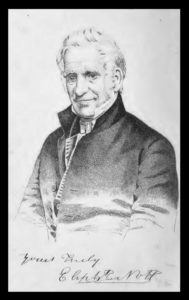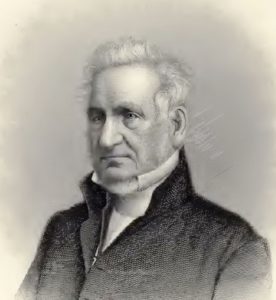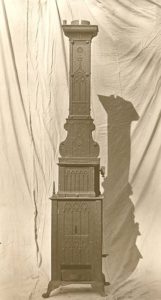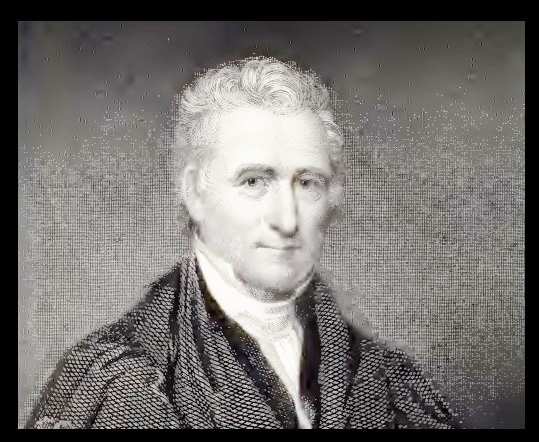 Eliphalet was born June 25, 1773 to Deborah (Selden) and Stephen Nott in a cottage in East Haddam, Connecticut. It is not known why Eliphalet was chosen for his name, but the spelling matches one of David’s sons in the King James Version (2 Sam. 5:16). The Hebrew means, “God delivers.” Stephen Nott was in the mercantile business but when his business failed he had to move the household from place to place due to difficult economic times. Tension with Great Britain was increasing and the colonies were headed towards the Revolutionary War. The family could not afford to have Eliphalet attend school, so Deborah taught him at home until he was sent to live with his twenty-years-older brother Samuel who was pastor of the Congregational Church in Franklin.
Eliphalet was born June 25, 1773 to Deborah (Selden) and Stephen Nott in a cottage in East Haddam, Connecticut. It is not known why Eliphalet was chosen for his name, but the spelling matches one of David’s sons in the King James Version (2 Sam. 5:16). The Hebrew means, “God delivers.” Stephen Nott was in the mercantile business but when his business failed he had to move the household from place to place due to difficult economic times. Tension with Great Britain was increasing and the colonies were headed towards the Revolutionary War. The family could not afford to have Eliphalet attend school, so Deborah taught him at home until he was sent to live with his twenty-years-older brother Samuel who was pastor of the Congregational Church in Franklin.
Life with his brother did not go well because Samuel was, according to Eliphalet, a domineering disciplinarian, nevertheless, he stuck with his studies under the task-master keeping his eyes on college entrance. His intellectual capabilities were recognized by others which resulted in his hiring at the age of sixteen to teach in the district school in Franklin. After a year of classroom teaching, he left Samuel’s house to become principal of Plainfield Academy. The pastor of the Congregational Church, Joel Benedict, tutored his continuing studies in Latin, Greek, theology, and mathematics. The bumpy road to college ended at the gate of Rhode Island College (Brown University) which had been founded by the Philadelphia Association of Baptists in the eighteenth century. Having completed less than a year of college studies, he was granted the master of arts when he passed an examination. His mother, task-master brother, personal diligence, and tutoring by Pastor Benedict had contributed to delivering Eliphalet from a considerable amount of classroom work and financial expense. A day after his twenty-third birthday, June 26, 1796, he was licensed to preach by the New London Congregational Association. The next month Eliphalet and Sarah Maria, daughter of Pastor Benedict, celebrated their dependence on Christ and each other by uniting in marriage on the day of the twentieth anniversary of national independence.
The couple showed their sense of adventure and missionary zeal when Eliphalet was Commissioned by the Domestic Missionary Society of Connecticut for ministry in the west. They moved to Cherry Valley in up-state New York which is located about sixty miles west of Albany. As was so often the case for ministers, Eliphalet added school teaching to his pastoral duties by starting an academy. His gifts as a preacher and pastor became known in the area resulting in his acceptance of a call presented to him by the First Presbyterian Church, Albany. He was ordained and installed October 13, 1798. During this era of American church history there was an informal connection between Congregationalists and Presbyterians for some ministries because both denominations held to the Westminster Confession of Faith as a constitutional document. In a few years, the Plan of Union would be effected which maintained the two denominations as separate entities but they were united officially for some efforts such as missions. Sarah died, March 11, 1804, possibly as a result of child birth given the brevity of their time together. A few months later on the sad occasion of the killing of Alexander Hamilton by Aaron Burr in a duel, Nott was asked by the local government, the Albany Common Council, to deliver a memorial which was published as A Discourse Occasioned by the Ever to be Lamented Death of General Alexander Hamilton.
 interest in education continued and when opportunities to assist academic institutions arose, he was willing to help while continuing ministry to the Albany congregation. In 1804 Jonathan Maxcy resigned from the presidency of Union College in near-by Schenectady. Union began under the presidency of John Blair Smith, then briefly was led by Jonathan Edwards, Jr., and then Maxcy was president for a few years. He had been president of Rhode Island College when Nott was a student. Maxcy’s poor health led to his leaving wintery New York to become founding professor of South Carolina College (University of South Carolina). The condition of Union College when Nott became president has been expressed in The New York Times as “it was without funds, without library or philosophical apparatus, in debt, and disheartened” (Jan. 30, 1866). Eliphalet took on the presidency and found Union burdened with considerable debt, and the first several years of his tenure were a struggle for survival. One method for obtaining funds came through the New York legislature which provided grants and allowed lotteries to be held. Nott and Union persevered with fiscal collapse of the college always a possibility, but through a combination of means he was able to put Union on a sound fiscal foundation. However, at one point during his presidency he was accused of mishandling funds, but a special committee appointed by the New York State Assembly reviewed the accounts and exonerated him. Under his presidency students were enabled to enjoy a greater measure of self-government and he introduced a science program that was offered along side the traditional classical curriculum. A stroke paralyzed him in 1859 forcing him to relinquish some duties, but he continued to preside at commencements until 1862. Eliphalet Nott died January 29, 1866. The funeral was held in First Church, Schenectady, with pastor of the church Jonathan Trumbull Backus leading the service. Nott was buried in the Vale Cemetery behind Union College. All in all, believe it or not, Eliphalet Nott was president of Union College for sixty-two years. It must be the longest tenure of any American university president. He was survived by his third wife, Urania E. Sheldon, whom he married August 8, 1842. He had one daughter, but she passed away earlier in his life. He and his second wife Urania E. Sheldon, a widow, were married August 3, 1807. She passed away in 1840.
interest in education continued and when opportunities to assist academic institutions arose, he was willing to help while continuing ministry to the Albany congregation. In 1804 Jonathan Maxcy resigned from the presidency of Union College in near-by Schenectady. Union began under the presidency of John Blair Smith, then briefly was led by Jonathan Edwards, Jr., and then Maxcy was president for a few years. He had been president of Rhode Island College when Nott was a student. Maxcy’s poor health led to his leaving wintery New York to become founding professor of South Carolina College (University of South Carolina). The condition of Union College when Nott became president has been expressed in The New York Times as “it was without funds, without library or philosophical apparatus, in debt, and disheartened” (Jan. 30, 1866). Eliphalet took on the presidency and found Union burdened with considerable debt, and the first several years of his tenure were a struggle for survival. One method for obtaining funds came through the New York legislature which provided grants and allowed lotteries to be held. Nott and Union persevered with fiscal collapse of the college always a possibility, but through a combination of means he was able to put Union on a sound fiscal foundation. However, at one point during his presidency he was accused of mishandling funds, but a special committee appointed by the New York State Assembly reviewed the accounts and exonerated him. Under his presidency students were enabled to enjoy a greater measure of self-government and he introduced a science program that was offered along side the traditional classical curriculum. A stroke paralyzed him in 1859 forcing him to relinquish some duties, but he continued to preside at commencements until 1862. Eliphalet Nott died January 29, 1866. The funeral was held in First Church, Schenectady, with pastor of the church Jonathan Trumbull Backus leading the service. Nott was buried in the Vale Cemetery behind Union College. All in all, believe it or not, Eliphalet Nott was president of Union College for sixty-two years. It must be the longest tenure of any American university president. He was survived by his third wife, Urania E. Sheldon, whom he married August 8, 1842. He had one daughter, but she passed away earlier in his life. He and his second wife Urania E. Sheldon, a widow, were married August 3, 1807. She passed away in 1840.
 In line with his educational interests, Nott served a parallel presidency for the Rensselaer Institute in Troy, 1829-1845. Rensselaer was founded to teach science and technology, which was right up Nott’s alley. He was president of the American Association for the Advancement of Education in 1850. He started the science curriculum at Union College, so it is not surprising he was interested in the subjects of thermodynamics and heat transfer. Eliphalet Nott invented the first stove for burning anthracite coal and developed improved flues for venting the products of combustion. Anthracite coal is a better fuel because it has more carbon content, burns cleaner, and produces greater heat energy. He received over twenty patents.
In line with his educational interests, Nott served a parallel presidency for the Rensselaer Institute in Troy, 1829-1845. Rensselaer was founded to teach science and technology, which was right up Nott’s alley. He was president of the American Association for the Advancement of Education in 1850. He started the science curriculum at Union College, so it is not surprising he was interested in the subjects of thermodynamics and heat transfer. Eliphalet Nott invented the first stove for burning anthracite coal and developed improved flues for venting the products of combustion. Anthracite coal is a better fuel because it has more carbon content, burns cleaner, and produces greater heat energy. He received over twenty patents.
Concerning his church work, he was moderator of the Presbytery of Albany when a particularly difficult case regarding a minister who was accused of plagiarism, building on another man’s foundation, and use of alcohol was adjudicated. He delivered the missions sermon at the meeting of the General Assembly of the Presbyterian Church in 1806, his passage was 1 Corinthians 15:58. He was also moderator of the General Assembly when it met in Albany in 1811. Nott did not deliver a retiring moderator’s sermon the next year because he was not in attendance. His publications include Miscellaneous Works of Eliphalet Nott (1810), Counsels to Young Men on the Formation of Character (1840), Ten Lectures on the Use of Intoxicating Liquors (1846), Lectures on Temperance (1847), Lectures on Biblical Temperance (1863), and finally, as edited by Taylor Lewis, The Resurrection of Christ: A Series of Discourses (1872).
Barry Waugh
Notes—According to The New York Times obituary and the Dictionary of American Biography he died January 29, 1866; according to his gravestone he died on the 23rd, but online material has it as the 25th. Information on Brown University is from Early History of Brown University, Including the Times and Correspondence of President Manning, Providence, 1897; Brown was founded as Rhode Island College but changed names as a result of a benefactor named Brown, and there is currently a college called Rhode Island College but it was founded in the 1850s. Information on Maxcy is from South Carolina Encyclopedia, editor Walter Edgar, article by Marcia G. Synnott, 2006. Maxcy is buried in the First Presbyterian Church of Columbia churchyard. The image of Nott’s stove is courtesy of the Union College Schaffer Library Postcard Collection. Memoirs of Eliphalet Nott, by C. Van Santvoord, 1876, is the best source of information on Nott. Another source is Robert Francis Seybolt, “Nott, Eliphalet,” in Dictionary of American Biography, ed. Dumas Malone. I did not have access to this book but it might provide a critical perspective, Eliphalet Nott, by Codman Hislop, Middletown: Wesleyan University Press, 1971. Regarding Nott and Union funds see, Francis and H. L. Wayland, A Memoir of the Life and Labors of Francis Wayland, 1867, 1, 90-92. Regarding the accusations against Nott see, In the Matter of Charges Presented by Certain Professors Against the President of Union College, The Argument of the President’s Counsel, Esek Cowen, Esq. Albany: Charles Van Benthuysen & Sons, 1883.





